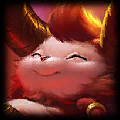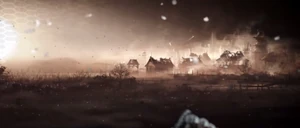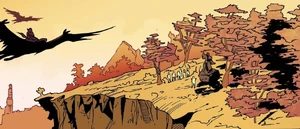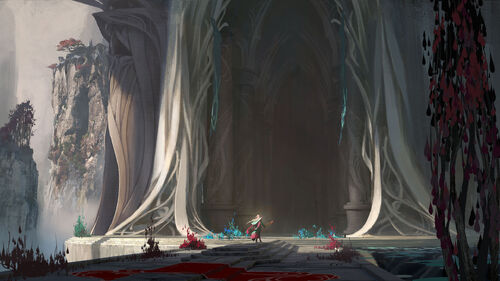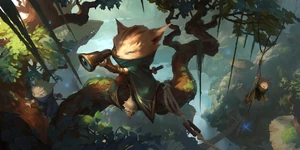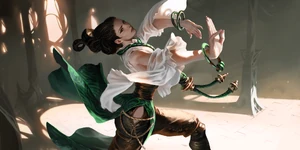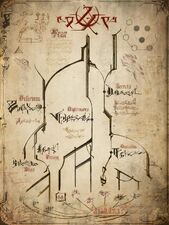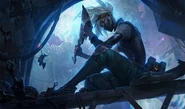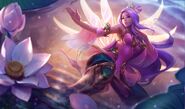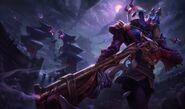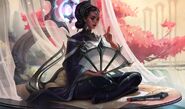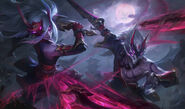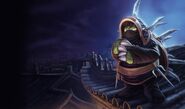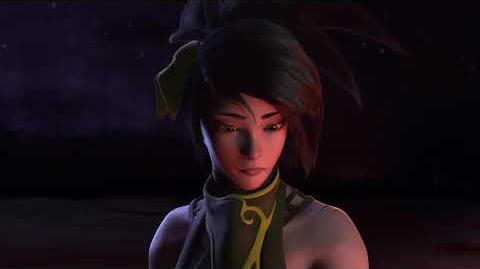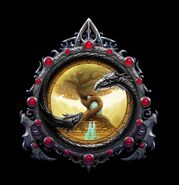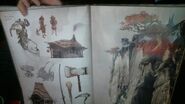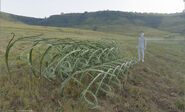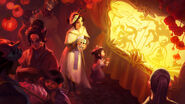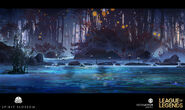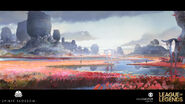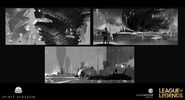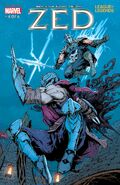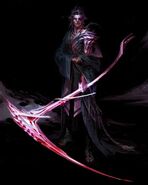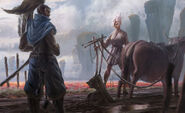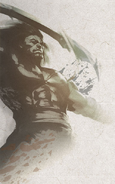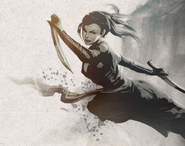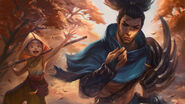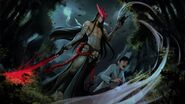| “ | ▶️ "We are the children of the First Lands, and we will not be slaves!" |
| — | |
Ionia, in original Vastayan nomenclature: The First Lands, is a land of unspoiled beauty and natural magic. Its inhabitants, living in scattered settlements across this massive archipelago, are a spiritual people who seek to live in harmony and balance with the world. There are many orders and sects across Ionia, each following their own (often conflicting) paths and ideals. Self-sufficient and isolationist, Ionia has remained largely neutral in the wars that have ravaged Valoran over the centuries - until it was invaded by ![]() Noxus. This brutal conflict and occupation has forced Ionia to reassess its place in the world. How it reacts and the future path Ionia will follow is as of yet undetermined, however, animosity against Noxus has led to militarization and vigilantism. Thirst for the dark arts is on the rise.
Noxus. This brutal conflict and occupation has forced Ionia to reassess its place in the world. How it reacts and the future path Ionia will follow is as of yet undetermined, however, animosity against Noxus has led to militarization and vigilantism. Thirst for the dark arts is on the rise.
Lore[]
Surrounded by treacherous seas, ![]() Ionia is composed of a number of allied provinces scattered across a massive archipelago, known to many as the First Lands. Since Ionian culture has long been shaped by the pursuit of balance in all things, the border between the material and spirit realms tends to be more permeable here, especially in the wild forests and mountains.
Ionia is composed of a number of allied provinces scattered across a massive archipelago, known to many as the First Lands. Since Ionian culture has long been shaped by the pursuit of balance in all things, the border between the material and spirit realms tends to be more permeable here, especially in the wild forests and mountains.
Although these lands' enchantments can be fickle, its creatures dangerous and fae, for many centuries most Ionians led lives of plenty. The warrior monasteries, provincial militias—and even Ionia itself—had been enough to protect them.
But that ended twelve years ago, when ![]() Noxus attacked the First Lands. The empire's seemingly endless warhosts savaged Ionia, and were only defeated after many years, and at great cost.
Noxus attacked the First Lands. The empire's seemingly endless warhosts savaged Ionia, and were only defeated after many years, and at great cost.
Now, Ionia exists in an uneasy peace. Different reactions to the war have divided the region—some groups, such as the Shojin monks or the Kinkou, seek a return to isolationist pacifism, and pastoral traditions. Other more radical factions, such as the Navori Brotherhood and the Order of Shadow, demand a militarization of the land's magic, to create a single, unified nation that can take vengeance on Noxus.
The fate of Ionia hangs in a delicate balance that few are willing to overturn, but all can feel shifting uneasily beneath their feet.
Champions of Ionia[]
Other Related Champions[]
- is a celestial who intervened at the Battle of Bard Mountain.
- was a Noxian field commander during the Noxian invasion.
- is searching for remaining Lunari in Ionia.
- is a Bilgewater pirate who ransacked Temple of the Jagged Knife.
- traveled to Raikkon and Sudaro in search of the Black Mist and any traces of recent Harrowings. He also later traveled to another Ionian village with his wife to protect its citizens from the Black Mist and help another Sentinel.
- is a Marai Tidecaller searching for the Aspect of the Moon in Ionia.
- was in Ionia, having been adopted by the Konte family after deserting Noxus and put on trial for the murder of Elder Souma. She was extradited back to Noxus.
- visited the Hirana Monastery during his search for the World Runes.
- Senna traveled to an Ionian village with her husband Lucian to protect its citizens from the Black Mist and help another Sentinel.
- participated in the slaughter of numerous Ionian citizens during the Noxian invasion.
- was born in Ionia and resided in an orphanage before being adopted by
 Buvelle House of Demacia.
Buvelle House of Demacia. - visited Ionia in the past.
- participated in the slaughter of numerous Ionian citizens during the Noxian invasion, and lost his arm to .
- was brought to Ionia during the Noxian invasion and was later trained under .
- is the vessel for four eternal spirits and defended Ionia during the Noxus invasion.
- came to Ionia in search of a fetter and corrupted .
- was born in Ionia, though he was captured and spent some time as a gladiator in Noxus before being released by Jarvan III.
History[]
Birth of the Vastaya[]
The Vastaya's origins can be traced back to a hidden corner of Ionia. The mortals lived in harmony with nature until a race of Titans came from the skies and waged war against them. Most enlightened mortals taken the power of the spirit realm into themselves, becoming the Vastayashai'rei to defeat the Titans. Initial generations of Vastayashai'rei were deathless and held immense magical power. Deciding to live among their mortal kin, their future descendants would start mixing with mortal kin and be known as the Vastaya - a blanket classification for any number of species of chimeric creatures. Over time, the varied offshoots began to settle in different regions and naturally adopted different forms - , , even - according to the creatures which most embodied their strongest characteristics.
Many Vastaya later migrated to faraway lands outside of their original home of Ionia.
Destruction of the God-Willow[]
- Main article: Green FatherSome of the Vastayashai'rei resided in the sacred grove of Omikayalan, the "Heart of the World". In its center stood the God-Willow. This massive tree, dripping with long gossamer leaves that shimmered with golden-green light, was of immense importance to both human Ionians and the Vastayan people of the continent, who guarded the tree from anyone who wished it harm. Unfortunately, the tree was destroyed by an invading war party from the Freljord, its leader transformed by its natural energy into the being known as , the Green-Father.
The Darkin War[]
- Main article: The Arrow of Retribution
Warring among themselves, the Darkin destroyed any who stood against them. With his , assassinated enemy commanders and champions, helping the Darkin defeat entire mortal armies with ever greater ease.
Eventually, Varus was cornered by Vastaya moon-stalkers and human mages in service of a golden-armored warrior queen of Valoran. They bound him within his bow, leaving him to howl in impotent rage. By then, the raw, corrupting influence of the Darkin was known, and yet still the queen chose to wield the deadly weapon in the final days of the war, gladly sacrificing herself for a greater victory.
In the months that followed, the queen carried Varus to the First Lands — those that would later be known as Ionia. Now made monstrous by the bow's power, her last act was to command her followers to bury her alive in a lightless well, sunk deep beneath a mountain temple overlooking the village of Pallas.
And there Varus was imprisoned, both by the natural magic of Ionia, and the ritual ministrations of the temple guardians.
The bow remained hidden for centuries, unknown, untouched, and all but forgotten.
The Golden Demon[]
- Main article: VirtuosoFor years, Ionia's southern mountains were plagued by the infamous “Golden Demon.” Throughout the province of Zhyun, a monster slaughtered scores of travelers and sometimes whole farmsteads, leaving behind twisted displays of corpses. Armed militias searched the forests, towns hired demon hunters - but nothing slowed the beast's grisly work.
In desperation, the Council of Zhyun sent an envoy to beg ![]() Kinkou Great Master Kusho for help. Upon hearing of the region's plight, Kusho feigned an excuse for why he couldn't help. But a week later, the master, his son , and star apprentice , disguised themselves as merchants and moved to the province. In secret, they visited the countless families emotionally shattered by the killings, dissected the horrific crime scenes, and looked for possible connections or patterns to the murders.
Kinkou Great Master Kusho for help. Upon hearing of the region's plight, Kusho feigned an excuse for why he couldn't help. But a week later, the master, his son , and star apprentice , disguised themselves as merchants and moved to the province. In secret, they visited the countless families emotionally shattered by the killings, dissected the horrific crime scenes, and looked for possible connections or patterns to the murders.
In time, they journeyed together with their master to track down the infamous Golden Demon. When they finally succeeded in capturing this feared “monster,” it was revealed to be a mere man named . The young Zed marched forward with his blades held high, but Kusho stopped him, ordering that Jhin be imprisoned in Tuula instead.
Though Shen and Zed both thought the killer deserved heavier punishment, Shen accepted his father's decision. He strived to emulate the Eye of Twilight's dispassion, and so found himself failing to console a bitter and resentful Zed.
The First Noxian Invasion[]
From its formation, the residents of Ionia preferred to pursue personal enlightenment instead of waging constant battles with other nations. The militaristic nation of Noxus saw their "weakness" as an opportunity. Noxian spies began to trade aggressively with the Ionians, traveling through provinces to study its weaknesses and identify critical targets.
Not long after, the warhosts set sail for Ionia as part of the long-planned Noxian invasion.
As the central province of Ionia, the invasion began in Navori, many villages and settlements fell, thousands of Ionians died as their magical artifacts were stolen to extend the life of their crazy emperor.
This aggression forced the religious leader , known for her peaceful teachings, to fight back. Across Navori, dissenting voices began to band together. A resistance was forming, one that would not rest until Ionia was free once more.
The return of Varus[]
- Main article: Heartlight
Two beast hunters— and his heartlight, —fought against the first wave at the Temple of Pallas. Though their courage was great and they drove off the attackers, Kai was mortally wounded, and a grief-stricken Val carried him inside, believing the well's forbidden magic could restore him.
But the temple held only damnation, and both hunters were consumed by the unleashed power of the Darkin within it. The very matter of their bodies was unraveled and bound together again to craft a new body, a body fit to free from his imprisonment. What emerged from the well was a gestalt creature, pale and inhumanly beautiful, part human and part Darkin. After more than a thousand years, Varus was reborn.
The Order of Shadows[]

Zed, the Master of Shadows
- Main article: Master of Shadows
The hunt for Jhin, left Zed haunted by his murders and he began to struggle in his studies. The rising tensions between Ionia and the imperialistic forces of Noxus only worsened his disillusionment. Many of the provinces were occupied by the enemy. Despite this, the Kinkou focused on maintaining spiritual balance and Kusho refused to fight back.
Zed ventured deep into the temple's hidden catacombs, and there he discovered a black box. Even though he knew it was forbidden, he peered inside. Shadows enveloped Zed's mind, feeding his bitterness with contempt for the weak, and hinting at an ancient, dark magic.
Zed demanded the Kinkou strike at the Noxian invaders with every means at their disposal. When Kusho refused, Zed left the Kinkou Order and their doctrines. He joined the growing resistance at Navori and raised a following of warriors to resist Noxus. Any soul who threatened his homeland, or stood idle in its defense, was marked for death without mercy—including native vastaya who wavered in their allegiance. Zed urged his followers to embrace the fervor of war, but he realized his own abilities would never match his ambitions without the black box.
Amassing his new acolytes, he returned to the Kinkou temple, where Kusho implored his former pupil to renounce the shadows in favor of a more balanced path. Zed answered bringing in one hand, the black box—and in the other, his freshly bloodied blade.
The Kinkou fell in droves as Zed's warriors cut them down. He then claimed the temple for himself, establishing his Order of Shadow, and began training his acolytes in the ways of darkness. They etched their flesh with shadowy tattoos, learning to fight alongside shrouded reflections of themselves.
Far from home, Shen felt an imbalance within the Kinkou Order—rushing back, he came upon the survivors of the bloody coup. Repressing his anguish against Zed, he led the remnants of the Kinkou to safety in the mountains. Shen took up his father's spirit blade, as well as the title of Eye of Twilight. Following the core tenets, he began to recruit and train others, hoping to rebuild the Kinkou Order.
Though Zed did not reconcile with Shen and the remaining Kinkou, now scattered throughout the provinces, they reached an uneasy accord in the aftermath of the war.
The Battle of Bard Mountain[]
- Main article: Bard Mountain (Video)

Battle of Bard Mountain.
Noxian troops tried to capture Bard Mountain and obtain a valuable magical artifact kept by the locals. During the battle, the village sage was tasked with taking the artifact to one of the Celestial shrines on the top of the mountain. The Noxians mortally wounded him with arrows before he could reach the shrine. But as his last act of defiance, he used the artifact to strike his would-be-killer, obliterating him and slicing a nearby peak in half. This misuse of the artifact's power had drawn the attention of a , who promptly intervened in the event. He retrieved the artifact and took it away from the mortal plane before the Noxians and Ionians could use its power for war.
Battle of the Placidium[]
- Main article: Blade Dancer

Noxian Ionian Invasion Map

Mural of the Noxian Invasion of Ionia
At one of the most important points of the war, a warhost lead by , captured the Placidium and took its defenders hostage, hoping to lure the inevitable reinforcements into a trap, but a 14-year-old girl named unleashed the power of Ionia ancient dances, and though it, the power of Ionia itself at the Noxians. A dozen of Swain's veterans fell, sowing chaos in their ranks as the other captives joined her before she struck down the general himself—the sight of this rebellious girl hefting his severed arm over her head would be the turning point of the war.
The growing resistance was led by Irelia for almost 3 years of war, but as Ionia united on resistance, Noxus doubled their war efforts, children were sent as foot soldiers, trying to exploit Ionian mercy and Chemtech bombs bought from an infamous bombarded both Ionians and Noxians.
Those Chemtech bombs had gruesome effects on the land. Perhaps the place where those consequences are most notable is the Wuju village, where rumors of a raised Noxian attention. In a single night, the entire village was destroyed, its people and culture obliterated by chemical fire. Even now, years after the end of the war, nothing can grow on this land and the souls of those who died on that horrible night lay trapped by the corrupted magics of their own land.
Toward the end of the war, the resistance once lead by Irelia eventually split into different military groups, including the Navori Brotherhood, an extremist group who believes Ionia should unite and militarize itself, teaching all nations to fear Ionia. The Navori Brotherhood is one of many groups at constant civil war in Ionia, fighting each other almost as bitterly as they fought the Noxians.
After almost three years of grueling battle since the Battle of the Placidium, Irelia triumphed over the killer of her family, Admiral Duqual, at Dalu Bay. She left the leadership of the resistance and shortly after the Noxian warbands retreated from Ionia due to power shifts on their own land...
The Dreaming Pool[]
- Main article: The Dreaming Pool

Syndra inside The Dreaming Pool
Many years have passed since the Noxian-Ionian War, in which both sides never achieved complete victory. While Ionians were able to repel further Noxian invaders from the heartland, Noxus still retained a few coastal territories. Among these was the island of Fae'lor, governed by a vastayan turncoat named Kalan.
Several Ionians that once called this island their home infiltrated its Noxian fort - formerly a monastery - in the hopes of reaching Dael'eh Ahira, the Dreaming Pool, and kill the immensely powerful who was imprisoned inside decades before. She was being guarded by Noxian forces, who the Ionians feared would accidentally release her and her power.
Their mission proved unsuccessful. Syndra was released, and Fae'lor was all but destroyed, its fortress lifted from the ground by the now freed into the sky and moved northward to an unknown location.
The Second Noxian Invasion[]
- Main article: AwakenIn a near future, Noxus will start its second attempt to conqueror Ionia, with joining the cause. They are met with resistance leaded by in a seaside village. Sion manages to overpower Irelia while the Noxian army is decimating Ionian farmers, but the arrival of , , and ultimately turns the tide of the battle.
Locations[]
Ionia is a large archipelago located off the east coast of Valoran. The currently well-known locations encompassing Ionia are:
Ionia Island[]
The main island of Ionia is split by a mountain range into two regions, Navori and Shon-Xan. It is also the location of the Ionian Capital, The Placidium, and Vlonqo.
[]
Located on Ionia, the province of Navori spans the western half of Ionia and is home to various villages, prestigious schools, sacred magical gardens, and the iconic Placidium of Navori.
- Azure Farms: are a coastal area in Navori region of Ionia.
- Garden of Forgetting: The garden may be located here. has visited the garden at least once to erase her troubled memories. Its keeper is Ighilya (Ionian: 'Great grandmother'), also known as the Eater of Secrets, the Forgotten, or the Witch Gardener. The flowers and the fruit of the Garden have deep magical properties that can take away a person's memories or life essence.
- Ionia City: A large city on which Ionians were gathered and harmonized by the magic that is within the First Lands. Magical Quinlons scatter all across the borders. Like any other nations, the Capital is the seat of power for the Ionian Ruling Council whose members include and .
- Omikayalan: known also as the Heart of the World or the Greenglade, is a sacred grove to all Ionians. The vastayashai'rei protected its most important landmark: the God-Willow, a massive tree, dripping with long gossamer leaves that shimmered with golden-green light. During ancient times, a battle between the groves protectors and Freljordian warriors ended with the God-Willow's destruction. The whimpers of countless beasts, the bawling of rivers, the howling of trees and the dripping tears of moss, they lamented the God-Willow's death in a symphony of mourning. Centuries have passed and at the place where the God-Willow once stood, a being known as the emerged with a clear mission and purpose: to protect all life and teach the world's people to respect and appreciate all that is.
- The Placidium of Navori: Situated at the heart of the continent, the Placidium is one of Ionia's most sacred places. Many have journeyed here to study at renowned schools, or meditate in its wild, magical gardens. Many of Ionia's most successful diplomats have spent at least some time studying at the Placidium. Undoubtedly, this was why it became such a tempting target for the invading armies of Noxus. It was at the Placidium that the people of Ionia finally took up arms against their Noxian enemies. But the cost of that day's victory was immense, and some now question if fighting back was the right decision, since the harmonious balance of their homeland may have been lost forever.
- Thanze: A city located in Southeastern Navori, it was ravaged by the Noxian Invasion of Ionia. The
 Navori Brotherhood and Zed's
Navori Brotherhood and Zed's  Shadow Order defended this city and its inhabitants.
Shadow Order defended this city and its inhabitants. - Temple of Koeshin: Located in Northwestern Navori, it is presumably the main headquarters of the
 Kinkou Order during the time of Master . The White Cliffs Inn, located closely to the Temple. is the place where and first met after decades in order to find .
Kinkou Order during the time of Master . The White Cliffs Inn, located closely to the Temple. is the place where and first met after decades in order to find . - Temple of Thanjuul: Located in Southeastern Navori, it is the
 Kinkou Order temple of Navori during the time of Master Kusho. During the siege of Thanze, Zed and his acolytes came for the Tears of The Shadow. Currently the Temple is controlled by the
Kinkou Order temple of Navori during the time of Master Kusho. During the siege of Thanze, Zed and his acolytes came for the Tears of The Shadow. Currently the Temple is controlled by the  Shadow Order.
Shadow Order. - Weh'le: Weh'le is a phantom port, a hidden coastal village, protected by the mystical properties of Ionia. Akali is a frequent visitor to the village, where she gets additions to her impressive dragon tattoo - and assassinates betrayers of Ionia seeking to flee the archipelago.
- Weh'le Market: One of the more important locations in Weh'le, during the Spirit Blossom Festival it is filled with entertainers.
- Weh'le River: Located next to the city. This small river holds great importance during the Spirit Blossom Festival, where numerous spirit blossoms bloom on its banks. Several shrines and titanic statues are scattered across the banks of the river. It is this place where and fought an azakana demon.
- Yasuo's Village: A place once ravaged by the Noxian invasion, it was once the location where warriors would learn rare Wind Techniques from masters like Elder Souma. It is the current residence of .
Shon-Xan[]
Not much is known about Shon-Xan, the eastern region of Ionia Island, though it is presumably the origin of one of favorite weapons, the Shon-Xan footed glaive.
- Puboe: A human town that was the center of a few recent events. and freed several vastaya from a prison here, and was assigned to kill a corrupt councilman who sold the town out to Noxus, though the murder did not actually occur in Puboe.
- Puboe Prison: Previously controlled by Shadow Order disciples, the Prison was used to imprison numerous vastaya.
- Temple of Xuanain: The village Xuanain is located in the southeastern part of Shon-Xan. It is located near a Kinkou Temple which was abandoned long ago until it became the new base of operation for the order after the death of Master Kusho during the Noxian invasion of Ionia. East of Thanjuul, high up in the mountains where glacial water ran. It was beside a lagoon of turquoise water, peppered with purple lantern florae. Although they were near the village of Xuanain, their haven was difficult to access, with its great elevation and surrounding hills.
- Vlonqo: A remote mountain town in southern part of Sho-Xan region of Ionia. Vlonqo Flowers are highly sought after by Weh'le tattoo artists.
Fae'lor[]
Fae'lor is a small island to the west of the main island of Ionia. It is the location of the Dael'eh Ahira, the Dreaming Pool, which previously imprisoned . Its famous monastery school was converted into a Noxian fort during the invasion. The island has since been stripped bare by Syndra's power, and the fort ripped free of its foundations.
- Fae'lor Castle: The fortress of Fae'lor was built upon the westernmost island of Ionia. Highly defensible, this place had remained for centuries, standing against countless foes, before being finally overrun after a long siege during the Noxian invasion. Its famous monastery school was converted into a Noxian fort during the invasion.
- Dael'eh Ahira Pool: Dael'eh Ahira, or the Dreaming Pool, a spiritually magical pool that previously imprisoned . Currently it imprisons a vastaya named Kalan.
Bahrl[]
Bahrl is an island in the central part of the chain, south of the main island of Ionia. The villages of Tevasa and Wuju are located here, as is the Epool River, where found .
- Epool River: It is located in the southern part of Bahrl island in Ionia. It is the place where found .
- Tevasa: It is located on the north side of the island region of Bahrl. At the footholds of the mountain, there is a small peaceful village with approximately hundred people. During the Noxian invasion of Ionia, pillaging Noxian soldiers were defeated by the hands of who grew attached to all the villagers and had a desire to protect them from harm.
- Urvash: A coastal settlement located in southern part of Bahrl island of Ionia.
- Wuju: Located on Bahrl, it is the birthplace of and the art of Wuju. It has since been destroyed during the Noxian Invasion of Ionia.
Bard Mountain[]
Possibly is located somewhere in Ionia. It was the site of a battle over an ancient artifact that resulted in the appearance of .
Houhjo[]
The Houhjo are an Ionian human tribe that occupy the two southernmost islands of the Ionian Archipelago, Galrin and Sudaro. The Houhjo's culture is centred around their custodial duties within The Temple of Pallas, which fell into disrepair after the Noxian invasion detailed in the comic, Heartlight, as well as the subsequent emergence of the Darkin, . Little is known of this island nation other than its involvement in Varus' backstory.
- Galrin: One of two islands in the region of Houhjo (the other being Sudaro), located near the southern tip of the Ionian Archipelago island chain.
- Ghetu Sea: The Ghetu Sea is a desert located at the center of the Galrin island of Ionia.
- Nistaram Forest: Nistaram Forest is located on the northernwest tip of Galrin island of Ionia. It is a day away from Pallas by horseback. This forest is rich with biodiversity, having numerous dangerous monsters and plants. Professional hunters are often enlisted to hunt down dangerous creatures that pose a threat to neighboring towns and villages.
- Pallas: The ancient village Pallas was established upon the coastal shores. The inhabitants of this village have forgotten much of their long history, but their duty as custodians to the Temple of Pallas was never abandoned - until Noxus arrived.
- Temple of Pallas: Aeons ago a gold-armored figure arrived upon the western shore of Ionia, bringing with her an insatiable device. Here she imprisoned a bow within a deep chasm and sealed it off using the natural magic from the Ionian landscape. The nearby settlement was tasked with maintaining the seals as what lurked inside was powerful enough to break its bonds and eventually be unleashed. Erecting a grand temple around the chasm, the villagers rarely wavered from this task, despite its purpose being entirely forgotten. sought refuge in the water-filled chasm when Noxian forces attacked Pallas, and the darkin Varus was released. Master
 Kobayashi was the Temples leader during the Battle of Pallas, where she was later slaughtered by Noxian soldiers.
Kobayashi was the Temples leader during the Battle of Pallas, where she was later slaughtered by Noxian soldiers.
- Temple of Pallas: Aeons ago a gold-armored figure arrived upon the western shore of Ionia, bringing with her an insatiable device. Here she imprisoned a bow within a deep chasm and sealed it off using the natural magic from the Ionian landscape. The nearby settlement was tasked with maintaining the seals as what lurked inside was powerful enough to break its bonds and eventually be unleashed. Erecting a grand temple around the chasm, the villagers rarely wavered from this task, despite its purpose being entirely forgotten. sought refuge in the water-filled chasm when Noxian forces attacked Pallas, and the darkin Varus was released. Master
- Sudaro: A small island at the southern tip of the Ionian Archipelago. It is part of Houhjo region along with Galrin.
Oulin, Qaelin, and Ralin[]
These islands make up a small cluster in the northeastern part of the archipelago. Hirana Monastery is located on Ralin.
- Hirana Monastery: The monks of Hirana Monastery are renowned for self-control. and defended this place.
- Lhotlan Village: Deep within the Lhradi Forest of Qaelin live the endangered Lhotlan vastaya, whose most prominent members are and .
- Qaelin Highlands: The mountainous regions of Qaelin which span from the north to the south of the island.
- Jiekkasja: A settlement and region located in the Southern Qaelin Highlands.
- Quenjo Estate: The current location of House Quenjo and the Lady Yevnai. visited this place in order to find the current whereabouts of during his search for .
- Jiekkasja: A settlement and region located in the Southern Qaelin Highlands.
Zhyun[]
A mountainous island in the south of the Ionian archipelago, it was previously plagued by the infamous . Before the Invasion of Ionia, Zhyun was known to have its own council.
- Kashuri: It is a coastal settlement located at the southern part of Zhyun island of Ionia.
- Kashuri Armories: The armories forged traditional weapons for a long time, mostly swords and bows. The war against Noxus changed that, and they began making poor copies of Piltover's hextech weapons. Now they have been 'inspired' to make new weapons harnessing the abundant magic in Ionia, like pistol-rifle.
- Nanthee: A settlement located in Southern Zhyun, it is where a disguised went in search for after his return. It was heavily destroyed by Jhin's bombs which he used for his escape to Piltover.
- Raikkon: A coastal settlement in the southern tip of Zhyun island of Ionia. Its native berries are used for creating quality tattoo ink mixture. was born here.
- Swirl Rocks: A unique rock formation located in the northern part of Zhyun island of Ionia.
- Temple of the Jagged Knife: Located in the island province of Zhyun, it is controlled by Order of Shadows. It was previously ransacked by and his pirate crew.
- Tuula: A city located in the southern mountainous province of Zhyun. was initially imprisoned here by Kusho, , and .
- Tuula Prison: A highly fortified prison for one of the worst criminals in Ionia. It is the place where was imprisoned for years before being released by corrupt Ionian politicians.
- Zhyun Highlands: The mountainous regions of Zhyun which span from the north to the south of the island.
- Ghajan River: Located in Southern Zhyun, the Ghajan river is the area where Kusho, and finally captured .
- Jyom Pass: A fishing settlement located on the banks of the Ghajan River. This was where was captured by Kusho, , and . There is a Blossom Festival held here.
- Holn: Located in the Southern Zhyun Highlands. The Holn Mountain Road had the statue of Master Kusho, the former leader of the
 Kinkou Order who banished a local demon, The Zogao. It is also the location where defeated and killed Master Althon.
Kinkou Order who banished a local demon, The Zogao. It is also the location where defeated and killed Master Althon. - Kotha: A village settlement in the Southern Zhyun Highlands, it was destroyed and most of its inhabitants brutally murdered by during his early years as a serial killer. It is also the location where Kusho, and first witnessed brutality. The village remains in ruins to this day.
- Olgathee Forest: Located in the Zhyun Highlands, it is the place where banished a demon which terrorized the surrounding areas.
- Temple of Raishai: The Village of Raishai is located in the southern part of Zhyun. The Raishai acolytes had been among the Kinkou order's most faithful, supporting the edict of pacifism during the Noxian Invasion of without question. The turmoils of the war lead to deep spiritual unrest in this area, which attracted evil spirits. It was only with the help of that this evil was dispelled.
- Shual: A settlement located in Southern Zhyun Highlands, it is one the locations where and went to in search for after his return.
- Sotka River: A river that originates from the Southern Highlands of Zhyun. Near Kotha it is one of the places where was searching for after his return. A Local Blossom Festival was ravaged by Jhin's bombs used by him for his escape.
- Thonx: A settlement located in the Zhyun Highlands, its river caverns have numerous taverns and fishermen buildings.
- Kwol Tavern: A river side tavern located at the outskirts of Thonx, it is the place where and his
 Shadow Order have started their search for .
Shadow Order have started their search for .
- Kwol Tavern: A river side tavern located at the outskirts of Thonx, it is the place where and his
- Ghajan River: Located in Southern Zhyun, the Ghajan river is the area where Kusho, and finally captured .
- Zhyunia: A coastal settlement located on Zhyun island of Ionia.
Wildlife[]
The people of Ionia's many provinces have always seen themselves as part of the natural world, and adapted their ways to live alongside all manner of fantastical flora and fauna. To outsiders, such a close relationship may appear strange, but it is through this interdependence that both the land and its inhabitants have thrived for countless generations.
Bahrl Jays[]
Bahrl Jays are an avian species native to the Ionian island region of Bahrl. They are quite active during the morning and they have melodic song like chirps.
Cloud Drinkers[]
Cloud Drinkers are large fish-like creatures that originate from Ionia. Their unique features are their long fins that are used as wings. These white scaled creatures live in high altitudes, consuming nutrients from the clouds. Its songs could be heard from the villages. Long, low waves of sound rippling from sky to hillside, each as formless and strange as the afternoon clouds.
Dragons[]
- Main article: Dragons
Winged, elemental-breathing reptiles that can reach near-giant sizes over their long, long lifespans, they are the indisputable ruler of the skies. Both fearsome and majestic, dragons have a society that revolves around strength and might and because of their egoistic and narcissistic pride, mixing their blood with that of races outside of dragonkind are seen as an abomination, a cancer that must be eradicated utterly. Many dragons persecute such defiled creations and their perpetrators to no end, a thing that , the Half-Dragon, found out firsthand. According to , Ionia has over 200 different species of talking dragons. Those who study these dragons speak of ancient, elemental runes split between the bloodlines. Empyreans are a breed of wingless wind dragons of Ionia that reside above the clouds, constantly moving with the wind.
Dreaming Tree[]
The Dreaming Tree grew from a seed of the God-Willow, which towered over the ancient grove of Omikayalan. Cast loose when the God-Willow was tragically felled, the seed took root in what came to be known as the Garden of Forgetting. Nurtured by the Green Father, —as many of the descendants of Omikayalan were—the Dreaming Tree spiraled up, spreading the magic of humanity's desires each time the dream-laden buds bloomed.
Ghost-Willow[]
One of the oldest magical trees in Ionia, it was destroyed by when she was a child.
God-Willow[]
One of the oldest magical trees in Ionia, it was destroyed centuries ago by Ivern the Cruel, who absorbed its power and became the .
Herald of Spring[]
Herald of Spring is a mythical creature that resides in Shon-Xan of Ionia. A Stag like being, it has the ability to bring new life and bring the end of winter.
Ionian Citrus Fruit[]
| “ | ▶️ "This from |
| — | |
Ionia have their own Citrus fruit, likely similar to a real-world Orange, that is completely seedless. Nothing is known about how it reproduces. How similar these fruit's evolution and genetics are to real world citrus fruit is unknown.
Jeweled Protectors[]
The Jeweled Protectors are giant mythical winged carnivores of Ionia with a mix of tiger and lion features. ![]() Protectors are born wingless and without manes until
Protectors are born wingless and without manes until ![]() a certain age when they grow their manes while their wings grow out from their backs. Their other noticeable features are their two tails and gems embedded along their spines and forehead that glow with a mysterious power.
a certain age when they grow their manes while their wings grow out from their backs. Their other noticeable features are their two tails and gems embedded along their spines and forehead that glow with a mysterious power.
Kiwas[]
Kiwas are a type of fruit that can be found on Zhyun of Ionia. Its sweetness is said to help soak solemness whenever someone is too melancholy.
Luonn Kon[]
![]() Luonn Kon are giant spirit animals located in Ionia. They take the appearance of massive stone golems and are often benevolent in nature. Some of them assist local inhabitants in creating makeshift dams.
Luonn Kon are giant spirit animals located in Ionia. They take the appearance of massive stone golems and are often benevolent in nature. Some of them assist local inhabitants in creating makeshift dams.
Poros[]
- Main article: Poro

A particularly  1 nimble Poro defeating a
1 nimble Poro defeating a  Navori
Navori  2 brigand and
2 brigand and  2 highwayman.
2 highwayman.
are an are the mysterious, magical, and most-loved creatures originating from the Howling Abyss. Poros are equal parts truth, valor, and innocence. The colour of their fur is described as “very light blue, like ![]() Freljordian snow”. They have a heart-shaped underbelly because they're made of love. A poro's horns perk up when it's excited and droop down when it's scared. Poros paddle through deep snow with their front paws. Some believe that poros are indestructible. Poros stick their tongue out because they are incredibly warm. This is why they can survive the harsh cold environment of the Howling Abyss. are frosted with Freljordian ice crystals and are a favourite treat of this creature. The leader of the Poros is known as the .
Freljordian snow”. They have a heart-shaped underbelly because they're made of love. A poro's horns perk up when it's excited and droop down when it's scared. Poros paddle through deep snow with their front paws. Some believe that poros are indestructible. Poros stick their tongue out because they are incredibly warm. This is why they can survive the harsh cold environment of the Howling Abyss. are frosted with Freljordian ice crystals and are a favourite treat of this creature. The leader of the Poros is known as the .
There is at least one Poro found in Ionia. They were so inspired by ![]() 9 Minah Swiftfoot that they have started defending Ionian roads from the
9 Minah Swiftfoot that they have started defending Ionian roads from the ![]() Navori Brotherhood.
Navori Brotherhood.
Raikkon Berries[]
Raikkon Berries are a type of flora native to Raikkon on the island of Zhyun, these berries along with the enchanted flower petals from Vlonqo are used by tattoo artist of Weh'le as tattoo ink mixture.
Sapphire Roses[]
Sapphire Roses are a type of rose native to Ionia. Some merchants have adapted them to the robust Kumangra soil. Sold in the markets of Kumangra, their distinct sent is heavily sought after by flower collectors.
Scaled Snapper[]
Scaled Snappers are giant turtle-like lizard creatures that reside in Ionia. One of the oldest inhabitants of the Greenglade, they have withstood the test of time through constant adaptation.
Serpentleaf[]
![]() Serpentleaf is a type of predatory flower native to the Nistaram Forest of Galrin. Serpentleaf poultice, if properly made, is used as an effective healing agent that dulls the pain but not the mind. If the flower isn't picked properly, its leaves are poisonous. The flowers lure insects with its scent and color. Some animals have adapted an immunity to the flowers poisons, eating it from the inside when its leaves close.
Serpentleaf is a type of predatory flower native to the Nistaram Forest of Galrin. Serpentleaf poultice, if properly made, is used as an effective healing agent that dulls the pain but not the mind. If the flower isn't picked properly, its leaves are poisonous. The flowers lure insects with its scent and color. Some animals have adapted an immunity to the flowers poisons, eating it from the inside when its leaves close.
Sun Apples[]
![]() Sun apples are a common type of tree located in Ionia. Its fruit can warm a person and even tan a person's entire body.
Sun apples are a common type of tree located in Ionia. Its fruit can warm a person and even tan a person's entire body.
Vlonqo Flowers[]
Vlonqo Flowers are a type of flower endemic to the southern faces of the Vlonqo cliffs. Their enchanted flower petals along with Raikkon berries of Raikkon are used by tattoo artist of Weh'le as tattoo ink mixture.
Vulkodalk[]
![]() Vulkodalk is native to the Nistaram Forest of Galrin. This terrifying predator is a theropod-type creature with eight eyes on each side of its head, a large horn atop the snout, and a maw with multiple rows of pointed teeth.
Vulkodalk is native to the Nistaram Forest of Galrin. This terrifying predator is a theropod-type creature with eight eyes on each side of its head, a large horn atop the snout, and a maw with multiple rows of pointed teeth.
Windfarers[]
Windfarers are mythical creatures of Ionia's cliffsides. Their unique aspects are their mixed avian and feline features, having cat-like heads and bodies while having avian feet and wings. Their fur is of different shades of white while their feathers of different shades of grey. Windfarers lay eggs like birds and their young hatch during the beginning of the Ionian spring.
Worax[]
These herd animals are described as goat-like buffalo. Pregnant Worax are considered to be quite noisy.
Xaolans[]
Xaolan trees, known for their gossamer flowers, is a type of tree from Zhyun in Ionia which leafs and flower petals are used to create white tea.
Zephyr Sage[]
Zephyr Sage is a mythical avian creature that resides somewhere in Ionia. The unique features of this giant being is his emerald green, brown, and white feathers. It is believed that this creature is a wise sage that is able to aid people in their quests.
The people of Ionia's many provinces have always seen themselves as part of the natural world, and adapted their ways to live alongside all manner of fantastical flora and fauna. To outsiders, such a close relationship may appear strange, but it is through this interdependence that both the land and its inhabitants have thrived for countless generations.
Lighted Lilies[]
![]() Lighted Lilies are a type of aquatic flora native to Ionia, such as the Lake of Lighted Lilies. The unique feature of these pond lilies is their ability to produce light from the head of the flower.
Lighted Lilies are a type of aquatic flora native to Ionia, such as the Lake of Lighted Lilies. The unique feature of these pond lilies is their ability to produce light from the head of the flower.
Rivers of Grass[]
![]() Quite literal rivers of grass, flow and move with the tides of magic. Landfishers, if intinued with the magic of the landscape, can cultivate and collect all the grains and fruits that grow in these areas.
Quite literal rivers of grass, flow and move with the tides of magic. Landfishers, if intinued with the magic of the landscape, can cultivate and collect all the grains and fruits that grow in these areas.
Yellow Crabs[]
Culture[]
The Ionian continent is a haven for those who seek spiritual evolution and enlightenment. Magic suffuses every part of Ionia—its people, its history, and most of all the land itself. All aspects of life there hang in a balance, with still so much left to be discovered and explored. Those who call this vast continent home strive to find harmony among the diverse races and habitats, far older than most others on Runeterra. While populated primarily by humans and vastaya, some yordles and other beings also make Ionia their home. There are many spiritual centers and schools of enlightenment in Ionia, though they might not always agree about important questions. Such pursuits leave little time for thoughts of imperialism; the Ionians have historically been extremely peaceful by nature. That does not mean, however, that they are helpless or unable to defend themselves.
It is certain Ionia has a much longer and richer history than any living soul could claim to know. Indeed, in the more remote mountain passes, the landscape is still littered with evidence of great wars from ages past—but instead of clearing the ruins, the Ionians choose to respect what remains, even if they no longer fully understand what it represents.
The Path To Enlightenment[]
While it is true that harmony is sought by most in Ionia, few are so far along this path as to be considered truly enlightened beings. Their ideals are lofty, but not all can live up to them, and Ionians can be just as driven by hate, lust, anger, and love as any Runeterran. From Hirana to the Placidium of Navori, there are places of sanctuary open to those trying to better understand themselves.
Ionia is home to many human languages & dialects, though the Zhyun dialect is the most-spoken of the Ionian dialect chain, possibly descending from the ancient Ionian language still used by to chant her mantras. It's unknown if and speaks another dialect from the same dialect chain or a completely different language.
- Ionian kinship terms:
(PIE-based?[1])- Anar - "Brother" (cf. *ɐnḗr "man")
- Dyeda - "Daughter" (cf. *dʰugɐtḗr "suckling")
- Erzai - "Son" (cf. *wérsēn ~ *r̩sḗn "man")
- Emai - "Mother" (cf. *(x)am- baby word)
- Faʔir - "Father" (cf. *pɐtḗr "protector ~ provider")
- Svasa - "Sister" (cf. *swésōr "same-blooded")
- O-fa - "Grandfather" (also to address an elderly man)
- O-ma - "Grandmother" (also to address an elderly woman)
- language:
- Other:
- Jhin - Golden Excellence.
- - Gatekeeper.
 Kobayashi (小林) - Small Forest (possibly from Yasuo's language)
Kobayashi (小林) - Small Forest (possibly from Yasuo's language)- Nargui - No One.
- Rakhsasum - Collector.
- - Destruction (?).
Apart from the human languages on Ionia, there is also the Vastayan language, one of whose various dialects is Baraashi, as spoken by Lhotlan's tribe-members and .[2]
(Baraashi used elements of the Finnish & Arabic languages as its basis)
- Vastaya Baraashi dialect (Lhotlan Tribe)
- Baasi - I (future tense).
- Eli, Ella - Love (masculine, feminine).
- Example of a Vastayan conversation.
- Faash - They (present tense).
- Ighilya - Great Grandmother.
- Iminha - Little One.
- Mi - My.
- Mieli, Miella - My Love (masculine, feminine).
- ▶️ Mu'takl - A slang for "Blood traitor".
- Na - To not be.
- Om - Magic.
- Ouulavaash - Farewell.
- Soura - To Gather.
- ▶️ Taitah be tervaash - Rest in peace/well.
- Tann - Here.
- Va'h - To be (present tense).
- Vastaya - Vastaya (the people).
- Vi - Wild.
- Vi-om - Wild-magic.
Architecture[]
Ionia's millennia of isolation has meant that this balance-attuned culture placed a high value on keeping up healthy traditions. These customs and attitude often manifest in Ionian architecture. The structures built here are characterized by a sense of natural flow and grace, aspiring to reflect the ethereal beauty of the land. Also, grand, open spaces ensure that one is never fully divorced from what organically existed there before.
- Farms: Living in harmony with the land means that form tends to follow nature. Farms and villages sit gracefully within the environment. Their floors, doors, and walls echoing the rise and fall of the earth and sky.
- Living Housing: Unlike houses in places such as Demacia, where people would cut down trees, turn them into planks and then nail them together into houses, Ionians respect nature. They do not want to upset the local tree spirits. Doing so would have negative repercussions for them, their families, and further generations. Instead they would hire local woodweavers, who would try and convince the trees to grow in house-like shapes most beneficial for the future occupants. However, due to it being living housing, the tree branches can grow and move, sometimes seemingly over night due to natural magic of the trees.
- Rooftop Garden: Ionian architecture often includes organically curved tiled or shingled roofs. Here, branches extend outward from the trees within this building.
- Temples: Some temple houses in the highland valleys are shaped into the rocky hillsides, with living whipwillows serving as archways and support columns. The transitions between the walls and other elements of these sacred buildings are smooth to the touch, with few hard edges or corners.
- Quinlons: The magical filters and damns used by humans scattered. They are made from a circle of rotating massive rocks, orbiting around each other, floating in the sky, existing as great wards that contain ancient enchantments, which hold back and limit the natural magic of the land to more favourable and helpful magic to humans. This in turn affect the Vastayan livelihood due to their dependence on magic. and his Shadow Order use them to create their ichor which is used to channel Shadow magic.[3]
Clothing[]
Ionian clothing comes in various shapes, sizes, coloring, and designs as diverse as its people. Due to easy access to various flora and fauna, Ionian clothing incorporates rich patterns and colors inspired by the surrounding nature. The Lhotlan vastaya use the heads and feathers of Raptors as ornate accessories, while other Vastaya use large insect wings and flowers in their clothing. People of higher standing tend to have clothing with rich patterns and accessories, with large ornate decorative headdresses and shoulder pauldrons. Those of lower standings such as farmers and villagers have more earthy and practical garments. Some Ionian orders and other organizations have their own unique clothing laws and traditions.
- Tattoos: Tattoos are a common with Ionian youth such as those found on Weh'le. has a traditional design of an Ionian Dragon etched on her back, while has hers going across her right leg.
Demonic Compendium[]
A fragment of esoteric lore, discovered after the attack on the Noxian fortress at Fae'lor. The author(s) and provenance are unknown.
The compendium shows several types of demons that branch out from three root branches, the primary one being Fear. The types of demons that spawn from Fear are: Nightmare, Secrets (which further branches out to Obsession), and Delirium (which further branches out to Bliss and Frenzy), and currently unknown brances. Nine inscriptions of what are likely names of demons all point towards "Azakana". Around the branches, several images can be seen, such as the image of Raum, Fiddlestick's keys, and an image showing 10 circles.
The inscription is written in a currently unknown language, possibly connected to Ochnun or the Noxian writing system, as it was found in a Noxian stronghold.
Tools[]
- Boats: Ionian boats much as their architecture has a more elegant design. Made out of dead or fallen tree branches, leaves, and/or other floral parts the boats can also vary in shapes and sizes depending on the need of the users.
- Farming Equipment: Ionian farming equipment is mostly crafted from dead or fallen tree branches roped together with a metal head in various shapes depending on the need of the users. Carts, wheels, and other farming objects are made of easily bending dead tree branches and vines which are then shaped, stitched, and connected into desired shapes.
- Tellstones: A variant of Tellstones called "King's Gambit" is played in
 Demacia. It is named after a Demacian King Santon the Great. King Santon of Demacia avoided civil war with a game of Tellstones, saving thousands of lives. Despite the game's popularity across Runeterra, no one seems to know where Tellstones originated. There is a variant of Tellstones played by the
Demacia. It is named after a Demacian King Santon the Great. King Santon of Demacia avoided civil war with a game of Tellstones, saving thousands of lives. Despite the game's popularity across Runeterra, no one seems to know where Tellstones originated. There is a variant of Tellstones played by the  Dauntless Vanguard and they use it to settle disputes within the ranks.
Dauntless Vanguard and they use it to settle disputes within the ranks.
Spirit Gods and Folklore Spirits[]
Spirit Gods that originate from Ionia are tied to nature and are often seen as the guardians of Ionia's forests, including its Spirit Trees, which are venerated in a similar fashion.
Ionian folklore is rich with many stories of benevolent or trickster spirits, jealous demons, and tragic characters. These spirits have interacted with mortals during the ![]() Spirit Blossom festival, when the veil between the Spirit Realm and Physical Realm are thin. Some of these spirits related to the festival are even known beyond Ionia (e.g. is the same with an Ionian interpretation), however, it is unclear just how many of these most of these spirits are worshiped or venerated enough to be classified as spirit gods.
Spirit Blossom festival, when the veil between the Spirit Realm and Physical Realm are thin. Some of these spirits related to the festival are even known beyond Ionia (e.g. is the same with an Ionian interpretation), however, it is unclear just how many of these most of these spirits are worshiped or venerated enough to be classified as spirit gods.
Ionian Afterlife[]
- For more information, see
 Spirit Blossom.
Spirit Blossom.
While Ionians venerate numerous spirit deities, such as (known as ![]() the Taker),
the Taker), ![]() the Gatekeeper and the Collector are one of the more important ones for the Ionian afterlife. The Gatekeeper, a white fox with a shimmering nine-tails, represents a capricious, whimsical spirit who sees the fate of the living as a game of chase, she offers the chance for souls to find their final rest but will not intervene if they stray from the path. If a person strays from the path of the Gatekeeper, they may end up being taken by other spirits or demons in the afterlife, one of which is the Collector. Jealous of the Gatekeeper, the Collector is a demon who haunts the spiritual afterlife as a supreme collector of souls, tempting the dead away from their path to salvation until they are trapped for eternity within their own memories. Warriors that are not able to move on from the events of their lives are the most susceptible by the demons lure, such as the elder brother from Ionian myths that took this path.
the Gatekeeper and the Collector are one of the more important ones for the Ionian afterlife. The Gatekeeper, a white fox with a shimmering nine-tails, represents a capricious, whimsical spirit who sees the fate of the living as a game of chase, she offers the chance for souls to find their final rest but will not intervene if they stray from the path. If a person strays from the path of the Gatekeeper, they may end up being taken by other spirits or demons in the afterlife, one of which is the Collector. Jealous of the Gatekeeper, the Collector is a demon who haunts the spiritual afterlife as a supreme collector of souls, tempting the dead away from their path to salvation until they are trapped for eternity within their own memories. Warriors that are not able to move on from the events of their lives are the most susceptible by the demons lure, such as the elder brother from Ionian myths that took this path.
The famed Spirit of Salvation, and the fox all mortals are beckoned towards when their souls arrive to the spirit realm.
Saga of the First Lands[]
The Saga of the First Lands is an Ionian legend retelling the tales of the mythical guardians of the lands.
| “ |
|
Shon Xan Poems[]
| “ |
|
Teachings of the Dragon[]
| “ |
|
Harvest Festival[]
Most Ionian settlements have their own way of celibrating a harvest festival. In Vlonqo, musicians, singers and dancers perform in front of the townsfolk to give thanks for another year of bountiful harvest. , a Lhotlan vastaya, sang old vastayan songs during one of Vlonqos harvest festivals.
Spirit Blossom Festival[]

Government[]
Not much is known about Ionia's government currently, but most areas seem to have regional administrations that don't always share philosophies. Each village has its own small council.
Schools of Learning[]
Ionia is home to countless schools and temples, which train disciplined students in ancient martial arts and esoteric philosophy. Deadly and graceful, these fighters, mages, dancers, and scholars spend years in training, hoping to master their craft and for the pursuit of enlightenment.
Though the birthplace of many specialized forms of martial arts, Ionia maintained no standing armies. Rather, the ways of battle are tied to differing philosophies, passed on with reverence and care. In the northeastern mountains, the monastery of Hirana has long been a sanctuary for those seeking to better understand their connection to the spirit realm.
During and after the Noxian invasion, many of these traditions were shaken. Extreme, hardline interpretations of their former beliefs have become more prevalent as each practitioner struggles to make sense of the world in the aftermath of all they have witnessed.
 Hirana Order[]
Hirana Order[]
The Hirana Monastery is home to many skilled and enlightened monks. Their adepts are some of the most devout proponents of personal harmony within one's self. Though the monks deplore violence, they are not defenseless as they are skilled enough to turn and redirect an opponent's strikes. In an act of selflessness, the monks took in , and taught him how to harness and control his animalistic fury... most of the time. blinded himself in a desperate fury while defending the monastery.
 Kinkou Order[]
Kinkou Order[]
The Kinkou are an ancient clan dedicated to the preservation of balance. Order, chaos, light, darkness - all things must exist in perfect harmony for such is the way of the universe. The Order is led by a triumvirate of ninjas - , , and - who uphold its causes in the world and are each entrusted with one of three sacred duties: Watching the Stars, Coursing the Sun, and Pruning the Tree. However, Akali has since left the order to pursue her own path.
[]
The Navori Brotherhood are an ultra-nationalist group established during the Invasion of Noxus. Although they aim to defend their people from foreign attackers, they also aspire to control the continent under one rule, and are willing to attack and kill fellow Ionians who don't align with their vision for Ionia - including .
 Shadow Order[]
Shadow Order[]
The Order of Shadows is a new clan that has dedicated themselves to learning the forbidden art of the shadows and killing anyone who refuses to learn. Their leader, , rediscovered these ancient techniques and used them to take over the Kinkou Monastery.
 Shojin Order[]
Shojin Order[]
The Shojin Monastery is home to peaceful monks that have long practiced the martial arts of inner healing. Through meditation, the monks are capable of rejuvenating from injuries at a heightened rate. Some of these priests can also display acts of incredible willpower, such as suffering through agonizing amounts of pain for weeks without crying out. was raised here.
 Wuju Order[]
Wuju Order[]
The was founded on obtaining absolute spiritual awareness of one's self and one's enemy. , the keeper of this ancient art, descended from one of the few tribes dedicated to the preservation of Wuju. Due to the massacre of his kin, Master Yi is now the last master of his art. He has pledged to keep the Wuju style alive by teaching the art form to other individuals, such as .Relations[]
 Bilgewater[]
Bilgewater[]
During Noxus' invasion of Ionia, many pirates from ![]() Bilgewater sailed to the island nation. For years they ruthlessly pillaged the settlements along the island's coastlines and fought naval battles with Ionian vessels when engaged. Even after the war, many Ionians still feel deep enmity towards Bilgewater due to its denizens' actions.
Bilgewater sailed to the island nation. For years they ruthlessly pillaged the settlements along the island's coastlines and fought naval battles with Ionian vessels when engaged. Even after the war, many Ionians still feel deep enmity towards Bilgewater due to its denizens' actions.
 Demacia[]
Demacia[]
While Demacia campaigned against Noxus's imperial ambitions, it was unable to prevent the disasters that were inflicted on Ionia. It is unclear if Ionians feel animosity towards Demacia as a result. Several key figureheads in Demacian society originate from Ionia, such as and .
 Freljord[]
Freljord[]
Not much is known about the current relations between the two nations. The first known interaction between the two cultures ended up with the destruction of the by a stranded band of Freljordian warriors... but the second was a friendship between and .
 Noxus[]
Noxus[]

The Great Stand Of The Placidium
The long planned Noxian invasion to Ionia began under Boram Darkwill orders. Rumors spread of abundant magic flowing from the land, convincing many Noxians to indulge in the conquest, seeking riches beyond their wildest dreams. But Darkwill desired immortality above all, tasking legions to search for anything relevant wherever it could possibly be obtained and annihilating those who stood in their way. In short time the presence of Noxians would increase and turn violent, eventually becoming a full-scale war.
Over the course of the invasion things became an uphill battle, the likes of which Noxians and Ionians had never experienced. As the Ionians fought in defiance, so did the land itself. This Ionian victory at the Great Stand at Navori a decade ago ensured that everyone in Ionia knew the name of , and looked to her for leadership. Exhausted and nearly defeated, the war would eventually end with ascension to power and most Noxian armies were withdrawn from Ionia. After the defeat of Noxus and the return of most annexed lands, it is unclear of the present political conditions. It is well-known, however, that many Ionians have a vendetta against Noxus.
 Piltover[]
Piltover[]
Ionia and Piltover have frequent enough trade with each other for relatively small shipping ports like Nanthee having piltover trading ships dock at its ports. Weapons from the city-state are acquired and modified for easy use in spirit magic rich Ionian land.
 Shadow Isles[]
Shadow Isles[]
Ionians have suffered under numerous Harrowings enacted by the undead of the Shadow Isles.
 Zaun[]
Zaun[]
Zaunite chemists such as , which the backing of Noxus, were able to commit horrific war crimes during the Noxian invasion of Ionia. Their chemical weapons decimated Ionian lands that have physical and spiritual scars to this day.
Trivia[]
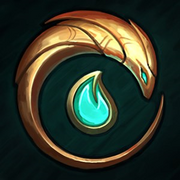
- The name Ionia comes from the Ancient Greek Ἰωνία, after the tribal name Ia(w)ones Ἰά(ϝ)ωνες, with unclear etymology, possibly from:
- The real-life namesake is Ionia, after Ionian Greek colonists, located in Anatolia, now in modern-day Turkey.
- There are also the Ionian Islands located at the western part of modern-day Greece.
- Ionian names are usually derived from Sino-Tibetan, e.g. , , , , etc. with some Berber influences[5]
- Exceptions exist, however: e.g. & from Indo-European; , , & from Japonic; from Korean, etc.

- In Season Nine, the ranked emblems for the League system were redesigned. Ionia represents the emblem for the
 Platinum rank.
Platinum rank. - Ionia's crest resembles Mantle of Decorum.
- Despite the origins of its name, Ionia is inspired by East Asia.
- Ionians practiced sky burials: the deceased's corpses are left to the elements and scavengers, then collected and cleaned by bone washers.[6] This funerary tradition is also practiced in the real world, in parts of China (including Tibet), Bhutan, Mongolia, and India.[7]
- Ionia has over 200 species of talking dragons.[8]
- Ionian prisons are known to be humane.[9] Unless they're run by more extreme factions such as the Order of Shadows.[10]
- Despite Ionia generally having low-tech weapons, their new high-tech weaponry is generally housed in the Kashuri armouries and used by people who have authorization by the regional authorities, such as .
- The serpent-like crest of Ionia features its colors - white, teal green, and honeysuckle.[11]
Media[]
- Related Music
- Related Videos
See also[]
References
- ↑ http://www.ling.upenn.edu/~rnoyer/courses/51/PIEKinship.pdf
- ↑ Vastayan Baraashi dialect
- ↑ A Piece of Shadow Cake
- ↑ Beekes, R.S.P. Etymological Dictionary of Greek, p. 594-595, 609
- ↑ https://nexus.leagueoflegends.com/wp-content/uploads/2017/12/Jhin_Namestorm_exvj79ng3h59rqlp70n8.pdf
- ↑ http://leagueoflegends.wikia.com/wiki/Confessions_of_a_Broken_Blade#II
- ↑ https://en.wikipedia.org/wiki/Sky_burial
- ↑ Irelia on talking dragons
- ↑ Jhin Q&A 1
- ↑ [1]
- ↑ Jhin Q&A 2
